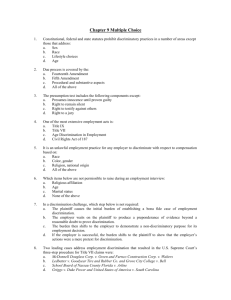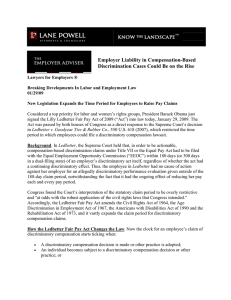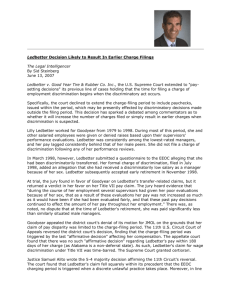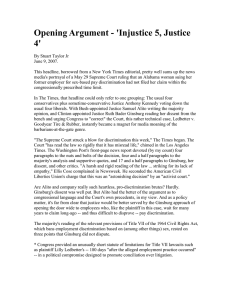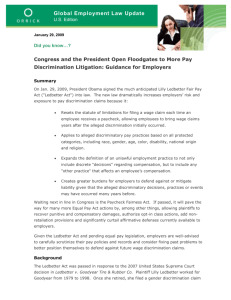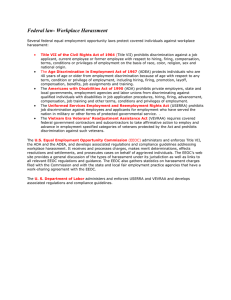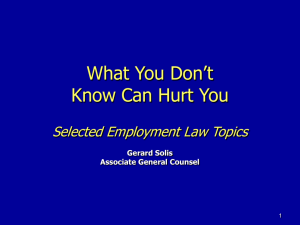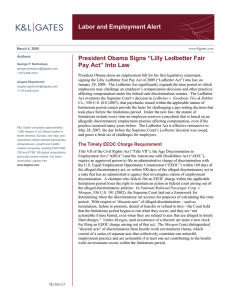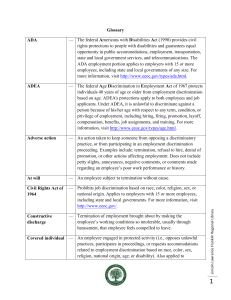Employment Law | Client Update
advertisement
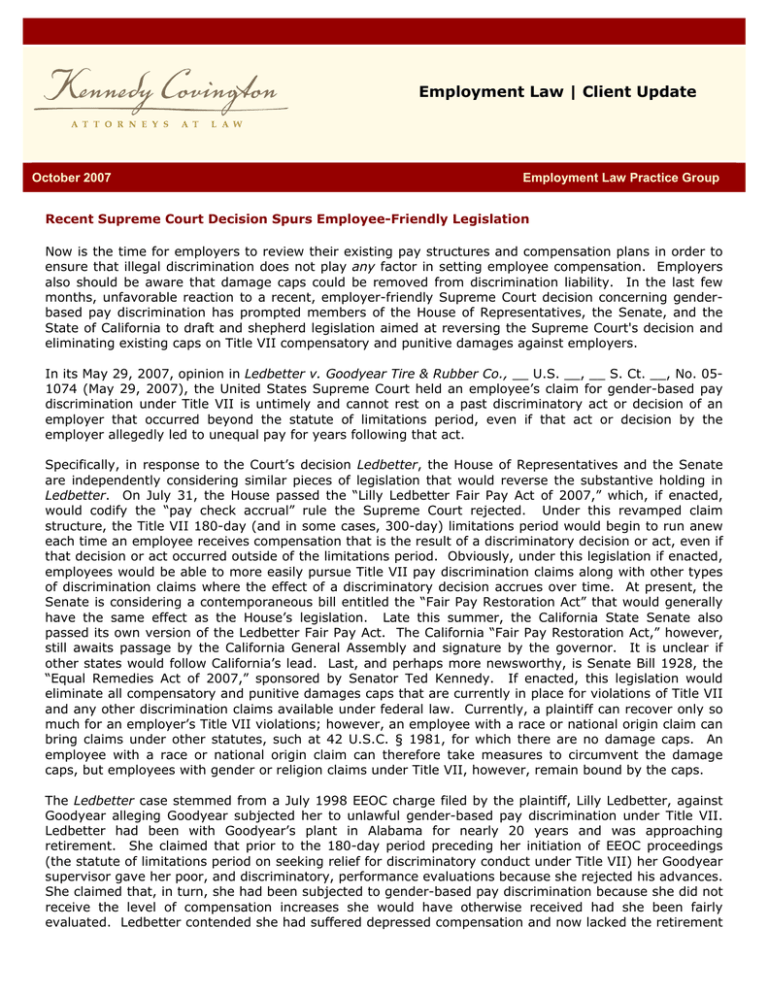
Employment Law | Client Update October 2007 Employment Law Practice Group Recent Supreme Court Decision Spurs Employee-Friendly Legislation Now is the time for employers to review their existing pay structures and compensation plans in order to ensure that illegal discrimination does not play any factor in setting employee compensation. Employers also should be aware that damage caps could be removed from discrimination liability. In the last few months, unfavorable reaction to a recent, employer-friendly Supreme Court decision concerning genderbased pay discrimination has prompted members of the House of Representatives, the Senate, and the State of California to draft and shepherd legislation aimed at reversing the Supreme Court's decision and eliminating existing caps on Title VII compensatory and punitive damages against employers. In its May 29, 2007, opinion in Ledbetter v. Goodyear Tire & Rubber Co., __ U.S. __, __ S. Ct. __, No. 051074 (May 29, 2007), the United States Supreme Court held an employee’s claim for gender-based pay discrimination under Title VII is untimely and cannot rest on a past discriminatory act or decision of an employer that occurred beyond the statute of limitations period, even if that act or decision by the employer allegedly led to unequal pay for years following that act. Specifically, in response to the Court’s decision Ledbetter, the House of Representatives and the Senate are independently considering similar pieces of legislation that would reverse the substantive holding in Ledbetter. On July 31, the House passed the “Lilly Ledbetter Fair Pay Act of 2007,” which, if enacted, would codify the “pay check accrual” rule the Supreme Court rejected. Under this revamped claim structure, the Title VII 180-day (and in some cases, 300-day) limitations period would begin to run anew each time an employee receives compensation that is the result of a discriminatory decision or act, even if that decision or act occurred outside of the limitations period. Obviously, under this legislation if enacted, employees would be able to more easily pursue Title VII pay discrimination claims along with other types of discrimination claims where the effect of a discriminatory decision accrues over time. At present, the Senate is considering a contemporaneous bill entitled the “Fair Pay Restoration Act” that would generally have the same effect as the House’s legislation. Late this summer, the California State Senate also passed its own version of the Ledbetter Fair Pay Act. The California “Fair Pay Restoration Act,” however, still awaits passage by the California General Assembly and signature by the governor. It is unclear if other states would follow California’s lead. Last, and perhaps more newsworthy, is Senate Bill 1928, the “Equal Remedies Act of 2007,” sponsored by Senator Ted Kennedy. If enacted, this legislation would eliminate all compensatory and punitive damages caps that are currently in place for violations of Title VII and any other discrimination claims available under federal law. Currently, a plaintiff can recover only so much for an employer’s Title VII violations; however, an employee with a race or national origin claim can bring claims under other statutes, such at 42 U.S.C. § 1981, for which there are no damage caps. An employee with a race or national origin claim can therefore take measures to circumvent the damage caps, but employees with gender or religion claims under Title VII, however, remain bound by the caps. The Ledbetter case stemmed from a July 1998 EEOC charge filed by the plaintiff, Lilly Ledbetter, against Goodyear alleging Goodyear subjected her to unlawful gender-based pay discrimination under Title VII. Ledbetter had been with Goodyear’s plant in Alabama for nearly 20 years and was approaching retirement. She claimed that prior to the 180-day period preceding her initiation of EEOC proceedings (the statute of limitations period on seeking relief for discriminatory conduct under Title VII) her Goodyear supervisor gave her poor, and discriminatory, performance evaluations because she rejected his advances. She claimed that, in turn, she had been subjected to gender-based pay discrimination because she did not receive the level of compensation increases she would have otherwise received had she been fairly evaluated. Ledbetter contended she had suffered depressed compensation and now lacked the retirement funds to which she would otherwise have been entitled had she not been subjected to the years of pay discrimination prior to 1998. The jury found for Ms. Ledbetter and awarded her backpay and damages. The Court of Appeals reversed the jury and the Supreme Court affirmed the Court of Appeals’ reversal. The Supreme Court’s central holding in the case was that Title VII’s statute of limitations barred Ledbetter’s pay discrimination claim because the “the specific employment practice at issue,” the poor performance evaluation years prior to the EEOC charge, started the limitations clock, not Ledbetter’s receipt of each paycheck issued over the course of years after the discriminatory decision. The Court held each paycheck resulting from one discriminatory act or decision cannot constitute independent and separate acts of discrimination. The Court rejected Ms. Ledbetter’s reliance on the “paycheck accrual” rule argument because she failed to introduce evidence of any such discriminatory compensation structure by Goodyear. Instead, Ledbetter alleged that her supervisors discriminated against her individually in the past, outside of the limitations period, resulting in subsequent years of reduced pay. That subsequent cascade of depressed compensation—in the form of smaller paychecks issued over the course of years stemming from discrete discriminatory decisions or conduct—did not trigger the running of a new limitations period each time Ledbetter was issued a new paycheck to allow her a valid claim. The decision in Ledbetter, and the quick congressional movement to reverse that decision, clearly suggests that employers should review their existing pay structures and compensation plans. So too, the decision may encourage employers to enlist input from a variety of people in compensation or other typical job-related decisions to ensure that discrimination does not play any factor. Since the legislation currently making its way through Congress not only would nullify the Ledbetter ruling, but would also remove the damage caps from Title VII, what was an employer-friendly ruling may actually result in a more employee-friendly lawsuit environment widening not only the scope of available discrimination claims but also the entitlement to monetary damages. It may become even more crucial for Human Resources and company leadership to train supervisors and managers to refrain from discriminatory conduct and avoid making discriminatory decisions since claims related to those acts that might have otherwise been barred by Title VII’s limitations period under Ledbetter may soon become sources of liability. Employment Law Tips: Effective Age Discrimination Releases Normally, when an employer enters into a severance agreement or other settlement with an employee (or former employee), the employer expects the employee to sign a release of claims against the employer. When the employee is over 40 and the employer wants a release of claims under the Age Discrimination in Employment Act (“ADEA”), the law requires that the release be “knowing and voluntary” to be effective. Regulations issued by the Equal Employment Opportunity Commission set out certain criteria that a release must meet to be found to be “knowing and voluntary.” A release that fails to meet these criteria will not be effective in releasing ADEA claims. The EEOC’s criteria for ADEA releases are described below: • Written agreement. Any ADEA release must be in writing, written in language designed to be understood by the employee, and must not be misleading or deceptive. • Mention the ADEA. The waiver must specifically mention that among the claims waived are claims under the ADEA. • Assistance of counsel. An employee releasing ADEA claims must be advised in writing to consult with an attorney prior to signing the agreement. • No waiver of future claims. accrued. An ADEA waiver may not release claims that have not yet • Consideration. No minimum amount of consideration is specified, but the consideration given must be something to which the employee was not otherwise entitled. • Review and revocation periods. An employee must be given 21 days to consider the offer after it is presented, although this period may be waived by the employee’s decision to sign the release earlier. In addition, the employee must be given 7 days to revoke his/her signature. The 7-day period cannot be waived. • Special rules for group terminations. When a group or class of employees is terminated (e.g., early retirement programs, RIFs, etc.) several special rules apply. First, these employees must be given 45 days to consider the offered agreement. Second, these employees must receive information regarding the unit, department, facility, or other class of employees affected by the termination program, including the job titles and ages of all employees in the same job unit or classification who are either selected or not selected for the program. Our employment law group provides advice and representation with respect to the unique and varied problems our clients face in dealing with an ever-changing work force. We work in partnership with our clients to help them with their every problem, whether day-to-day guidance or disputes that lead to litigation. Our attorneys bring to the table experience in litigating every type of matter and resolving disputes in an expedient manner. This bulletin is published as a service to clients and others interested in employment issues. The information provided herein is general in nature and should not be relied upon as legal advice as to specific factual situations. For more information, please contact: Russ Sizemore 704-331-7514 rsizemore@kennedycovington.com Employment Law Practice Group Amie Flowers Carmack Beverly A. Carroll Andrew M. Habenicht Glenn E. Ketner, III William C. Livingston Felicia Washington Mauney Daniel J. Palmieri Russell F. Sizemore Shannon S. Spainhour 919.743.7318 704.331.7586 704.331.7594 704.331.7580 704.331.7422 704.331.7466 919.743.7317 704.331.7514 704.331.7411 Celebrating our 50th anniversary, Kennedy Covington is one of the largest law firms in the Carolinas with offices in Charlotte, Raleigh, Research Triangle Park, Columbia and Rock Hill. Our more than 200 attorneys use their diverse experience and knowledge to counsel clients in varied industries such as banking and finance, real estate, technology, health care, manufacturing and the services sector. At Kennedy Covington, we give more than a legal opinion; we provide a business perspective. Kennedy Covington Hearst Tower, 47th Floor 214 North Tryon Street Charlotte, NC 28202 704-331-7400 www.kennedycovington.com © Copyright 2007 Kennedy Covington
